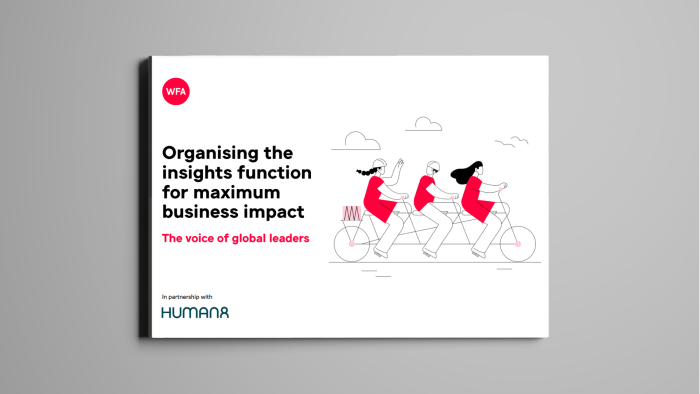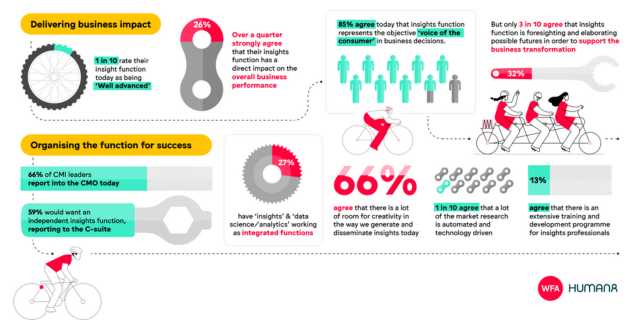Get analysis, insight & opinions from the world's top marketers.
Sign up to our newsletter.
New WFA research, conducted in partnership with Human8, provides a clear roadmap that enables global insights leaders to deliver maximum impact. Ioana Danila, Senior Manager, Global Insights at WFA, explains.

The world of insights is not getting any easier. Teams have to cope with increasingly complex business landscapes, evolving consumer behaviours and demands, increasing pressure on budgets, as well as working alongside more diverse teams with diverse capabilities across geographies.
Pushing the visibility and contribution of the function in such circumstances is no easy task.
Organising the insights function for maximum business impact found that delivering such impact requires ‘insights’ functions to combine a ‘deep human understanding’ with ‘business understanding’.

It also means highlighting the unique contribution of the function’s ability to bring an objective single voice of truth, independent of other business functions, in a volatile environment, as well as identifying a customer centric business strategy for growth and revenue.
This means being able to drive the strategic agenda, actions and decision-making so that the company is driven by insights, as well as developing a provocative vision for the future to generate business opportunities.
Based on 70 contributions from senior leaders from businesses collectively spending $50 billion on annual advertising, the report identifies six areas in which insights can supercharge its role and impact:
Around two-thirds of insight leaders believe that generating impact is best done through being a proactive advisor, collaborative relationships, being the objective voice of the consumer and curating insights for strategic business planning.
They confidently report that they truly represent the objective voice of the consumer in supporting business decisions: over 54% state that is a common reality today in their company. Many (37%) also indicate their departments currently have clear goals that are aligned with the business.
However, we notice that curating insights, taking a proactive advisory role, company-wide collaborative relationships and creative problem solving for brand growth are very often still intermittent realities.
There is room to grow in terms of being more “imaginative” and proactive, as well as leave a mark by “inspiration” beyond marketing and create “interdependence” through effective interfaces. Insight functions need to stress test their focus and push their boundaries to evolve from being operationally critical to being business critical.
There is a range of levels of maturity in the development of insights functions. Today, 14% indicate they are taking the first steps on the insights maturity journey, while 41% claim to be progressing well. Just 9% claim that their function is “well advanced”. In this context it is not surprising that two out of three insight functions have undergone a significant restructuring in the last three years in their quest to progress and advance.
66% of the respondents indicated that currently they report to the CMO, and just 20% claim to report directly to C-suite (with insights operating as an independent unit). However, if we look at the desired reporting structure, the ideal is to function is an independent unit, reporting directly into the C-suite at large. Almost 60% indicate they want to report directly into the C-suite, although 30% think being under the marketing department is ideal.
Next to getting access to the C-suite, there’s an ongoing conundrum around how to organise ‘human insights’ and ‘data science and analytics’. In seven out of the 10 cases, the insight and data science/ analytics operations are structured as separate teams. Half share no or hardly any resources.
Data is now nearly fully democratized and other departments have access to their own data, which they analyse and interpret. This can mean sometimes surfacing conflicting findings and might seem to be competing with the traditional ‘insight function’. Data science also uses C-suite friendly language.
The mission for the insights function is to triangulate methods & data and make sense holistically to become corporate storytellers that focus on the big idea, bring it to life and provide meaning. In 50 to 60% of cases, the collaboration with R&D, media and data science can be improved.
The insights leaders who participated in our survey research indicated that in 66% of the situations there is a lot of room for creativity in the way the insights are generated and disseminated.
Fifty-three per cent agree that their teams use a lot of standardised methods and formal procedures in their insights practice, but only 36% agree that the insights processes are efficient across the organisation. And only 10% agree that, today, their work in market research is automated and technology driven.
Senior insights leaders indicate that people and talent are well-developed in terms of skill variety for the here and now, with 72% indicating the insights function has people with varied skills and capabilities.
We also observe a profound insight talent development gap. The opportunity for job rotation is limited and mixed at best, a third say the opportunity is not present in their company. There is also no talent or career management practice present for people in an insight function: 43% of respondents indicate it is not available for their teams.
Insights function has work to do on interdependent relationships and mandates, being more imaginative as well as providing inspiration. However, most of the issues that stand out relate more to “how” things are done than “what” is done.
Organising the Insights Function for Maximum Business Impact identifies clear pathways to progress. What’s true is that getting insights function to generate meaningful business impact is a journey that should spur information-driven decision making.
WFA member? Download the report here.
The Insight Forum is WFA’s workstream dedicated to the global insight community. Through peer-to-peer learning, this group of 600+ global client-side insights and analytics leaders learns how to evolve their function towards playing an increasingly central role in their company’s transformation.
Want to get involved? Get in touch with Ioana.
Human8 is a human-driven consultancy that connects brands with people and culture to drive positive change. It uncovers what matters to people and advises brands how they can act upon it. Human8 provides consultancy services such as consumer closeness and empathy, innovation sprints, marketing (mix) modelling, portfolio strategy, brand and creative strategy as well as change management.

For more information or questions, please contact Ioana Danila at i.danila@wfanet.org